“I see a lot of patients with heavy upper eyelids. What we do is basically get rid of the droop. I make a special stitch that makes the skin fold in so when you open your eyes, the cut’s going to be right in the fold. The goal is to end up with a really nice eyelid that’s not droopy, not interfering with your vision or sitting on your eyelashes.” – Dr Beldholm
Book your appointment online now
In this video and article, Dr. Beldholm goes through a range of important facts you need to know about having a blepharoplasty. You will find information on:
- Who is suitable for an upper eyelid operation
- Can I use my health find and what are the Medicare item numbers
- Cost of the procedure
- Location and options for the operation
- Operation techniques
- Stitch removal
- Recovery
- Going back to work
Who is suitable for an upper eyelid operation
This photo of one of Dr. Beldholm’s patients demonstrates the ideal patient for an upper eyelid operation. One of the most critical factors in predicting the final result is the position of the eyebrow. As seen on this patient, the eyebrow has a normal position. The postoperative photo shows the result after the procedure!
As we age, unfortunately, everything **. The skin on the upper eyelid becomes loose and slides down to lie on the upper eyelashes. The forehead and eyebrows also start to droop.
There are two operations that apply to this area of the face, these are very different operations:
- Upper eyelid operation or blepharoplasty
- Brow lift operation
The critical factor in deciding which operation is suitable for you is the position of the eyebrow. If the eyebrow lies on or above your superior orbital rim (the bone that surrounds your eye socket) then you may be a candidate for blepharoplasty.
If the eyebrow lies below your orbital rim then you may consider having a brow lift.
Can I use my health fund and what are the Medicare item numbers?
The item number for the upper eyelid operation is: 45617
For more detailed information, visit the Medicare website.
This is what is written in the description for this item number:
“Upper eyelid, reduction of, for skin redundancy obscuring vision (as evidenced by upper eyelid skin resting on lashes on straight ahead gaze), herniation of orbital fat in exophthalmos, facial nerve palsy or posttraumatic scarring, or the restoration of symmetry of contralateral upper eyelid in respect of 1 of these conditions.”
This photo shows one of Dr. Beldholm’s patients. The arrow points to where the eyelid skin is sitting in relation to her upper eyelashes. She is a good example of someone who might qualify for the Medicare Item Number.
Navigating medicare and the private health funds can be quite confusing and complicated. That is why Dr Beldholm has a skilled patient coordinator that helps you through your surgical journey and helps you with things like medicare item numbers and health fund issues.
The guiding principle for medicare is that all health conditions and operations need to be for medical conditions and health related problems. Procedures done for purely cosmetic reasons do not qualify.
Upper Eyelid Surgery Costs
There are three costs that need to be taken into account for this operation:
- Hospital costs
- Anaesthetist costs
- Surgeon costs
Hospital costs for upper eyelid surgery
One of the main benefits of having a health fund is having the hospital paid for. You will only have the hospital paid for if you qualify for an item number. It is also important to remember that each health fund is different and it also depends on your level of cover. Some health funds have an excess that you need to pay for as well.
If you do not have a health fund then you will not be able to claim any of the costs of a private hospital back.
Anaesthetic costs for upper eyelid surgery
If you are having your operation in the Private hospital under a general anaesthetic, then you will need to pay these charges. Qualifying individuals may get a small amount back from medicare and if you have a health fund you will get a bit more back.
Surgeons fee for upper eyelid surgery
If you have a health fund then you may get some money back for your surgeon’s fee.
Total fee for blepharoplasty or upper eyelid operation
As you can see, if you have a health fund and get an item number then the final out of pocket fee is quite difficult to tell you upfront as it has so many variables. However once you have received your quote from the hospital, anaesthetist and Dr. Beldholm then you will be able to call your health fund and find out exactly what rebates you get back once you have had the operation.
What happens if you do not have health fund cover?
If you do not have Health cover then our all inclusive package price is: $6990. If you qualify for an item number, then you may be eligible to get some money back from Medicare.
What is included in this price?
- Pre and post op care by our nurses and Dr Beldholm. Once you have had your initial consultation with Dr. Beldholm then all subsequent visits are free of charge.
- Operation takes around 1.5 hours, if it goes longer you do not pay more.
- Hospital charges
- Anaesthetist charges
- Surgeons fees
- 6 LED light treatments with (Healite II LED). This helps any bruising or swelling after your procedure.
- Access to 24/7 emergency number after your procedure if you have any concerns.
- Our diamond service commitment
What happens when you are having your upper eyelid operation
Every step of the operation is critical for your result. From marking out where the cuts are going to be, to how your skin is sutured and how we take care of you after your operation.
Markings: The importance of precision

This photo shows one of Dr Beldholms’ patient’s after he has marked out her upper eyelids. The little arrow on the her left forehead points to a small Xanthelasma on her upper eyelid that will also be removed during her operation.

In this photo I’m testing the looseness of the upper eyelid skin to make sure that we are not going to make the upper eyelids too tight. – Dr. Beldholm
First of all, Dr Beldholm marks you out in your anesthetic bay. He always sees you just before the operation.
“I’ll do all my markings and we’ll have a chat about your expectations and what you can expect afterwards.” – Dr Beldholm
It is critically important to get these markings right. In an eyelid operation, being off by just a few millimeters makes a big difference in the final result. That is why Dr Beldholm spends a lot of time doing these markings with you before the operation starts.
The difficulty with upper eyelid surgery is that we put in local anaesthetic in the upper eyelids which distorts everything making it impossible without the markings to do the operation.
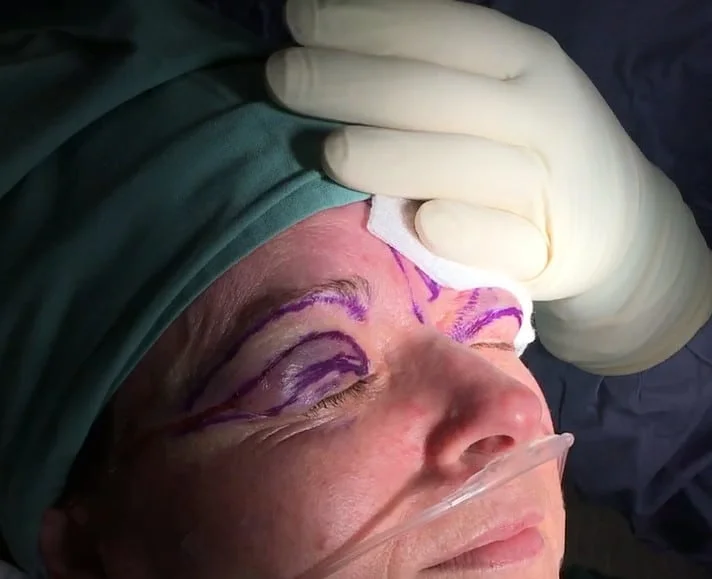
This photo shows the patient with local anaesthetic injected by Dr Beldholm. The upper eyelids are bulging out and are quite distorted. If the markings had not been done prior to the operation then it would have been impossible to tell how much skin to remove.
Removing the skin from the upper eyelids
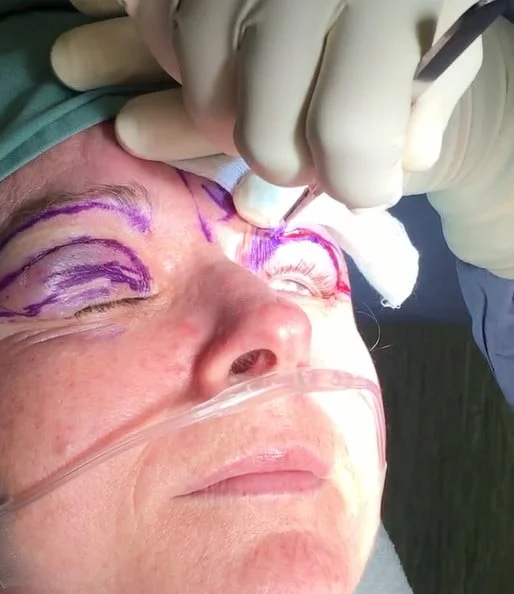
This photo shows Dr. Beldholm starting the incision for the left upper eyelid. The local anaesthetic has adrenaline in it. Adrenaline helps constrict the blood vessels and normally we do not get much bleeding during the operation. Dr. Beldholm uses magnifying loops to see all the small blood vessels to be able seal these.
There are a number of ways to remove the skin. They range from cutting the skin with a laser, using a diathermy to cut the skin or using a scalpel to cut the skin.
Laser Blepharoplasty versus Traditional Blepharoplasty
Dr Beldholm has used all the different methods of doing upper eyelid surgery. The main type of laser used for upper blepharoplasty surgery is the carbon dioxide (CO2) laser.
It is important to mention that this is not new technology. In fact, the CO2 laser has been around in medicine for close to 30 years. There is no benefit to this over other methods of cutting the skin. There are also research reports stating that the laser method is associated with a lot of complications. Making the incision with a scalpel, in Dr Beldholm’s experience, is a more precise method of doing the operation.
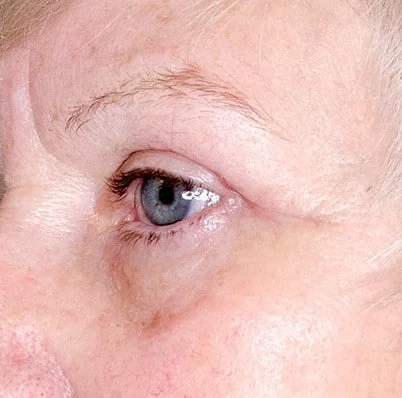
This photo shows one of Dr. Beldholm’s patients at six months after her operation. Dr. Beldholm has used many methods to cut the skin but has found that a scalpel gives as good, if not better results as compared to a laser. The instruments are important but surgical skill and experience is more important.
Once we have made the incision we gently remove the skin with a pair of scissors and then trim some of the orbicularis muscle as needed.
Trimming the fat pads
As we get older the connective tissue and the fascia surrounding the eye gets loose and the fat pads that in your youth are contained within the eyes start bulging out. To get a really nice and smooth result we need to trim these. There are two fat pads in the upper eye area: the medial and the lateral. Before we close the skin, we explore these and trim as needed.
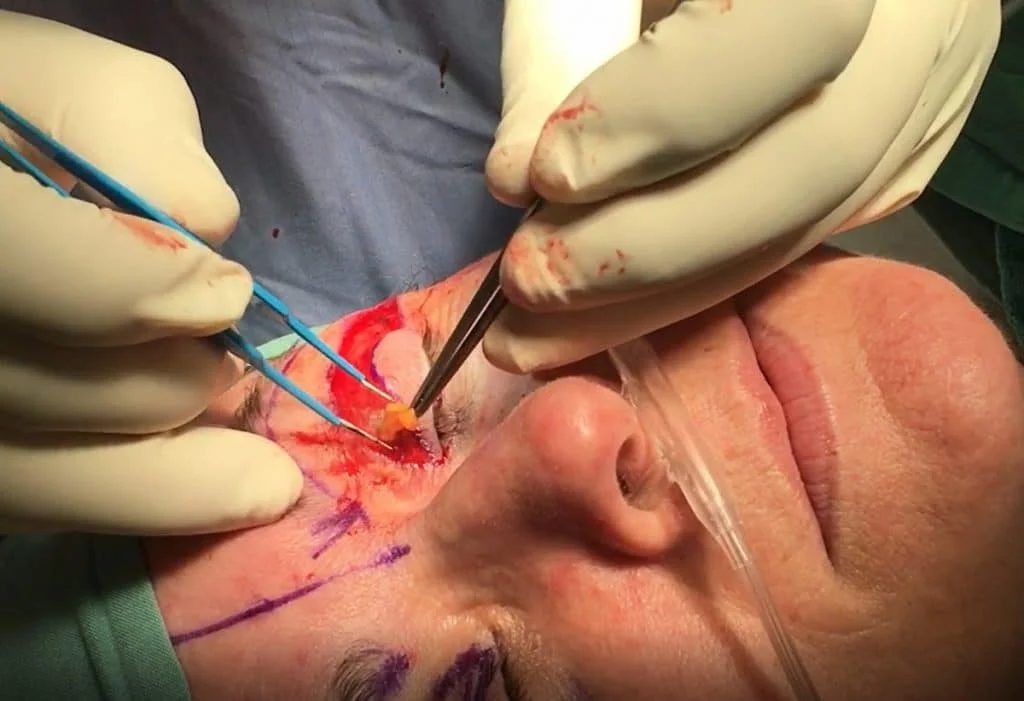
This photo shows Dr. Beldholm trimming the medial fat pad. This step needs to be done very gently as there are blood vessels deep in the eye that can be disrupted if too much tension is put on the fat pad. The instrument that Dr. Beldholm is using is called a bipolar forceps diathermy.
Book your appointment online now
Plicating the upper eyelid skin to the deeper structures
One of the big issues with aging upper eyelids is that the skin slides up and down the deep structures. This is what creates some of the ** and also the reason why we lose the upper eyelid fold as we age. It is therefore critical that we re-create the attachments. Not doing this will create a very poor result as the upper eyelid skin will still be ** even after the operation.
There are different methods in doing this. Some surgeons dissect out the so called tarsal plate (the upper eyelid cartilage) and stitch the upper eyelid skin to this. Dr Beldholm prefers to do a ** running suture into the deeper tissues without dissecting out the cartilage. The key to success with this method is to prevent the skin from sliding down and also re-create a nice ** upper eyelid fold.
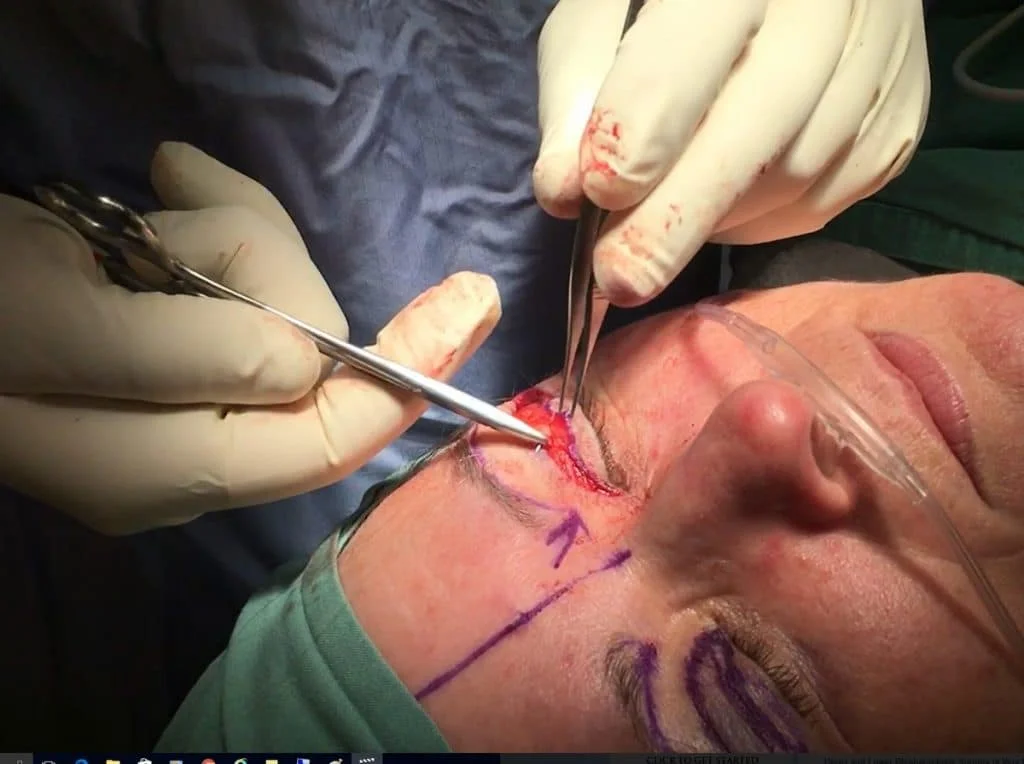
This photo shows Dr Beldholm using a very thin absorbable stitch called a “6/0 Caprosyn Suture” to stitch down the upper eyelid skin to the deeper structures to re-create the upper eyelid fold.
Final Closure
As with all things in surgery there are many different methods of closing the skin. Dr Beldholm has tried most of these and at the moment, he uses a very thin permanent stitch to close the skin. The other option is to use an absorbable stitch, the benefit of this is that it will not need to be removed.
“In the end the result is what is the most important thing to me. I found that when I was using absorbable stitches the scar was not as good as with the permanent stitches. There was bunching of the incision and the scar was much thicker in the end.” – Dr Beldholm
Recovery
“Most patients return to work in one or two weeks. We do LED light therapy in our office so that helps with the bruising and the swelling. The first week is usually the worst. You’ll have a little bit of bruising on the upper eyelid, although some patients bruise more than others. Sometimes you get a bit of bruising down on the bottom eyelid but that’s uncommon.”
“I use permanent stitches. They’re very, very fine stitches. I have used absorbable stitches in the past. However, what I found with absorbable stitches is that they bunch up the skin a little bit and actually the way they dissolve is that the body needs to eat the stitch up so you get inflammation and you get a much worse scar. The little fine stitch that we need to remove is a better choice in my experience. Our nurses here are very skilled and they just remove that at day 7 and after that you just wait for everything to heal up. Most patients find that the scar heals to a fine line, although everyone heals differently.”
Final thoughts on upper eyelid surgery
Having hanging upper eyelid skin can interfere with your vision and look unsightly. Upper eyelid surgery is one way to achieve more open, alert eyes with a fresher appearance.
Disclaimer: Individual results vary. All surgery carries risks & you should seek a second opinion before proceeding. See full Disclaimer


